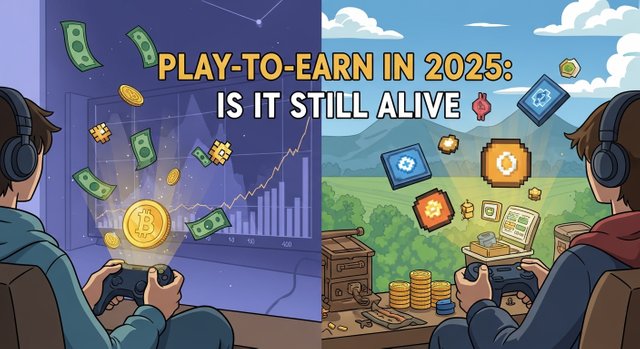Is Play-to-Earn Gaming Still Alive? Here's What I Found (Spoiler: It's Complicated)
Alright, let's talk P2E. Remember that frenzy? Axie Infinity blowing up, everyone and their grandma suddenly a "crypto gamer," dreams of quitting your day job because your digital pets paid the rent? Yeah, that. Feels like a lifetime ago, doesn't it? When the crypto winter hit and Axie kinda... imploded... a lot of us wrote the whole Play-to-Earn thing off as just another hype bubble that burst. Game over, man.
But hold up. Recently, I got dragged back down the rabbit hole. An old guild buddy pinged me about some new project, and honestly? Curiosity got the better of me. I dusted off my metaphorical crypto wallet (metaphorical because, let's be real, I actually forgot the password to my main one – rookie mistake, never again) and decided to poke around. Is there ANY life left in this P2E corpse? Or is it just zombie tokens shuffling around?
Here’s the messy, kinda surprising reality I found:
1. The "Get Rich Quick" Fantasy? Yeah, That's Mostly Dead (Thank God).
Let's be brutally honest: the early days were wildly unsustainable. Games built on pure ponzinomics – needing a constant influx of new players buying assets just to pay the old ones. It was a house of cards, and the wind blew hard. Axie's crash wasn't just a dip; it was a full-blown reality check. The days of expecting serious, life-changing cash from casually breeding pixel monsters? Gone. And honestly? Good riddance. That model was toxic and attracted way more speculators than actual gamers.
2. But... People ARE Still Playing (and Earning... Sometimes).
This was the big surprise for me. Logging back into some old Discord servers and subreddits... there's chatter. Not the manic, moon-bound screaming of 2021, but steady, focused discussion. Games like Splinterlands and Alien Worlds still have dedicated player bases grinding away. Are they making bank? Mostly, nah. We're talking small amounts – coffee money, maybe covering a Netflix sub if you hustle hard. But some people are making it work, often through serious time investment, understanding complex mechanics, and playing the market (buying/selling assets strategically). It’s more like a very part-time, unpredictable gig economy now.
3. The "Play" Part is Actually Getting (Slightly) Better?
This is the glimmer of hope. The sheer, unadulterated greed of the first wave seems to be giving way (slowly!) to a realization: if the game sucks, nobody sticks around to earn. I checked out a few newer entrants:
Some are focusing WAY more on core gameplay: Think actual fun loops, decent graphics (not just Unity asset flips), and mechanics that aren't solely about extracting value. The "earn" feels more like a bonus or reward for engagement, not the only reason to log in.
Less Reliance on Crazy Token Inflation: Newer models seem (emphasis on seem) more thoughtful about tokenomics. Trying to avoid the death spiral where rewards become worthless because everyone's dumping them. It's still crypto, so DYOR hard, but the intent feels different.
"Play AND Earn" vs. "Play-to-Earn": This subtle shift in wording is key. The best surviving projects understand the game needs to be fun first. The earning is secondary, an enhancement. Think of it like getting loyalty points at your favorite store – nice bonus, but you're there for the stuff.
4. The Guilds Evolved (Or Died).
Remember the massive scholarship guilds managing thousands of Axie teams? Many collapsed spectacularly. But the ones that survived? They got leaner, meaner, and smarter. They’re focused on specific games with actual potential, providing real training and support, and managing risk much better. They’re not promising lambos; they’re building communities around specific games and sharing knowledge on how to navigate the (still complex) earning aspects efficiently.
5. It's Niche Now. Really Niche.
Forget mainstream adoption. P2E, in its current form, is a playground for:
Hardcore crypto-natives who understand the tech and the risks.
Dedicated gamers in specific genres (TCG, strategy, some RPGs) who don't mind the crypto layer.
People in regions where even small crypto earnings make a tangible difference (this was always a key driver, honestly).
Speculators (still there, always will be), but hopefully less dominant.
So, Is It Alive?
Yes, but it's on life support compared to the glory days, and it looks completely different. The fever dream of easy money is dead and buried. What's left is a smaller, more cautious ecosystem learning (painfully) from past mistakes.
Alive? Technically, yes. Games are running, people are playing, tiny earnings are happening.
Thriving? Absolutely not. It's a fraction of its former self.
Worth Your Time? HIGHLY DEPENDS.
If you're looking for quick cash: Run. Just run. You're more likely to lose money.
If you're a crypto enthusiast who loves gaming: Maybe worth dipping a toe in. Research obsessively. Only risk what you can afford to lose. Focus on games that look genuinely fun.
If you just want a good game: Honestly? Stick to traditional games or Web2 games with cosmetic marketplaces. The P2E layer often adds friction and complexity without enough payoff yet.
My Takeaway?
P2E isn't dead, but it grew up fast and got punched in the face by reality. It's humbled. The survivors are (hopefully) building something more sustainable, where fun comes first and earning is a possible bonus, not the sole purpose. Is it the future of gaming? Probably not in its current form. But as an experimental niche blending gaming and decentralized economies? Yeah, it's still kicking, learning, and maybe – maybe – evolving into something less... exploitative.
It was weird diving back in. Felt nostalgic and kinda sad, but also... cautiously intrigued? Like seeing an old friend who got into some serious trouble but claims they're cleaning up their act. Only time will tell if they mean it.
What about you? Still playing any P2E? Found anything actually fun? Or are you happily staying far, far away? Let me know down below – genuinely curious!
